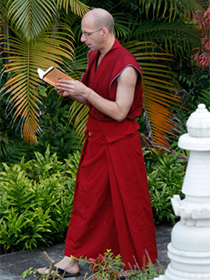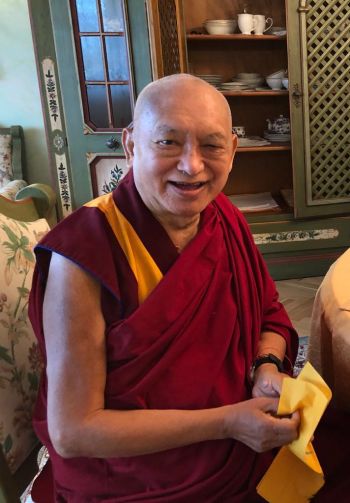- Home
- FPMT Homepage
Foundation for the Preservation of the Mahayana Tradition
The FPMT is an organization devoted to preserving and spreading Mahayana Buddhism worldwide by creating opportunities to listen, reflect, meditate, practice and actualize the unmistaken teachings of the Buddha and based on that experience spreading the Dharma to sentient beings. We provide integrated education through which people’s minds and hearts can be transformed into their highest potential for the benefit of others, inspired by an attitude of universal responsibility and service. We are committed to creating harmonious environments and helping all beings develop their full potential of infinite wisdom and compassion. Our organization is based on the Buddhist tradition of Lama Tsongkhapa of Tibet as taught to us by our founders Lama Thubten Yeshe and Lama Thubten Zopa Rinpoche.
- Willkommen
Die Stiftung zur Erhaltung der Mahayana Tradition (FPMT) ist eine Organisation, die sich weltweit für die Erhaltung und Verbreitung des Mahayana-Buddhismus einsetzt, indem sie Möglichkeiten schafft, den makellosen Lehren des Buddha zuzuhören, über sie zur reflektieren und zu meditieren und auf der Grundlage dieser Erfahrung das Dharma unter den Lebewesen zu verbreiten.
Wir bieten integrierte Schulungswege an, durch denen der Geist und das Herz der Menschen in ihr höchstes Potential verwandelt werden zum Wohl der anderen – inspiriert durch eine Haltung der universellen Verantwortung und dem Wunsch zu dienen. Wir haben uns verpflichtet, harmonische Umgebungen zu schaffen und allen Wesen zu helfen, ihr volles Potenzial unendlicher Weisheit und grenzenlosen Mitgefühls zu verwirklichen.
Unsere Organisation basiert auf der buddhistischen Tradition von Lama Tsongkhapa von Tibet, so wie sie uns von unseren Gründern Lama Thubten Yeshe und Lama Thubten Zopa Rinpoche gelehrt wird.
- Bienvenidos
La Fundación para la preservación de la tradición Mahayana (FPMT) es una organización que se dedica a preservar y difundir el budismo Mahayana en todo el mundo, creando oportunidades para escuchar, reflexionar, meditar, practicar y actualizar las enseñanzas inconfundibles de Buda y en base a esa experiencia difundir el Dharma a los seres.
Proporcionamos una educación integrada a través de la cual las mentes y los corazones de las personas se pueden transformar en su mayor potencial para el beneficio de los demás, inspirados por una actitud de responsabilidad y servicio universales. Estamos comprometidos a crear ambientes armoniosos y ayudar a todos los seres a desarrollar todo su potencial de infinita sabiduría y compasión.
Nuestra organización se basa en la tradición budista de Lama Tsongkhapa del Tíbet como nos lo enseñaron nuestros fundadores Lama Thubten Yeshe y Lama Zopa Rinpoche.
A continuación puede ver una lista de los centros y sus páginas web en su lengua preferida.
- Bienvenue
L’organisation de la FPMT a pour vocation la préservation et la diffusion du bouddhisme du mahayana dans le monde entier. Elle offre l’opportunité d’écouter, de réfléchir, de méditer, de pratiquer et de réaliser les enseignements excellents du Bouddha, pour ensuite transmettre le Dharma à tous les êtres. Nous proposons une formation intégrée grâce à laquelle le cœur et l’esprit de chacun peuvent accomplir leur potentiel le plus élevé pour le bien d’autrui, inspirés par le sens du service et une responsabilité universelle. Nous nous engageons à créer un environnement harmonieux et à aider tous les êtres à épanouir leur potentiel illimité de compassion et de sagesse. Notre organisation s’appuie sur la tradition guéloukpa de Lama Tsongkhapa du Tibet, telle qu’elle a été enseignée par nos fondateurs Lama Thoubtèn Yéshé et Lama Zopa Rinpoché.
Visitez le site de notre Editions Mahayana pour les traductions, conseils et nouvelles du Bureau international en français.
Voici une liste de centres et de leurs sites dans votre langue préférée
- Benvenuto
L’FPMT è un organizzazione il cui scopo è preservare e diffondere il Buddhismo Mahayana nel mondo, creando occasioni di ascolto, riflessione, meditazione e pratica dei perfetti insegnamenti del Buddha, al fine di attualizzare e diffondere il Dharma fra tutti gli esseri senzienti.
Offriamo un’educazione integrata, che può trasformare la mente e i cuori delle persone nel loro massimo potenziale, per il beneficio di tutti gli esseri, ispirati da un’attitudine di responsabilità universale e di servizio.
Il nostro obiettivo è quello di creare contesti armoniosi e aiutare tutti gli esseri a sviluppare in modo completo le proprie potenzialità di infinita saggezza e compassione.
La nostra organizzazione si basa sulla tradizione buddhista di Lama Tsongkhapa del Tibet, così come ci è stata insegnata dai nostri fondatori Lama Thubten Yeshe e Lama Zopa Rinpoche.
Di seguito potete trovare un elenco dei centri e dei loro siti nella lingua da voi prescelta.
- 欢迎 / 歡迎
简体中文
“护持大乘法脉基金会”( 英文简称:FPMT。全名:Foundation for the Preservation of the Mahayana Tradition) 是一个致力于护持和弘扬大乘佛法的国际佛教组织。我们提供听闻,思维,禅修,修行和实证佛陀无误教法的机会,以便让一切众生都能够享受佛法的指引和滋润。
我们全力创造和谐融洽的环境, 为人们提供解行并重的完整佛法教育,以便启发内在的环宇悲心及责任心,并开发内心所蕴藏的巨大潜能 — 无限的智慧与悲心 — 以便利益和服务一切有情。
FPMT的创办人是图腾耶喜喇嘛和喇嘛梭巴仁波切。我们所修习的是由两位上师所教导的,西藏喀巴大师的佛法传承。
繁體中文
護持大乘法脈基金會”( 英文簡稱:FPMT。全名:Found
ation for the Preservation of the Mahayana Tradition ) 是一個致力於護持和弘揚大乘佛法的國際佛教組織。我們提供聽聞, 思維,禪修,修行和實證佛陀無誤教法的機會,以便讓一切眾生都能 夠享受佛法的指引和滋潤。 我們全力創造和諧融洽的環境,
為人們提供解行並重的完整佛法教育,以便啟發內在的環宇悲心及責 任心,並開發內心所蘊藏的巨大潛能 — 無限的智慧與悲心 – – 以便利益和服務一切有情。 FPMT的創辦人是圖騰耶喜喇嘛和喇嘛梭巴仁波切。
我們所修習的是由兩位上師所教導的,西藏喀巴大師的佛法傳承。 察看道场信息:
- FPMT Homepage
- News/Media
-
- Study & Practice
-
-
- About FPMT Education Services
- Latest News
- Programs
- New to Buddhism?
- Buddhist Mind Science: Activating Your Potential
- Heart Advice for Death and Dying
- Discovering Buddhism
- Living in the Path
- Exploring Buddhism
- FPMT Basic Program
- FPMT Masters Program
- FPMT In-Depth Meditation Training
- Maitripa College
- Lotsawa Rinchen Zangpo Translator Program
- Universal Education for Compassion & Wisdom
- Online Learning Center
-
- Prayers & Practice Materials
- Overview of Prayers & Practices
- Full Catalogue of Prayers & Practice Materials
- Explore Popular Topics
- Benefiting Animals
- Chenrezig Resources
- Death & Dying Resources
- Lama Chopa (Guru Puja)
- Lama Zopa Rinpoche: Compendium of Precious Instructions
- Lama Zopa Rinpoche: Life Practice Advice
- Lama Zopa Rinpoche Practice Series
- Lamrim Resources
- Mantras
- Prayer Book Updates
- Purification Practices
- Sutras
- Thought Transformation (Lojong)
- Audio Materials
- Dharma Dates - Tibetan Calendar
- Translation Services
- Publishing Services
- Ways to Offer Support
- Prayers & Practice Materials
-
- Teachings and Advice
- Find Teachings and Advice
- Lama Zopa Rinpoche Advice Page
- Lama Zopa Rinpoche: Compendium of Precious Instructions
- Lama Zopa Rinpoche Video Teachings
- ༧སྐྱབས་རྗེ་བཟོད་པ་རིན་པོ་ཆེ་མཆོག་ནས་སྩལ་བའི་བཀའ་སློབ་བརྙན་འཕྲིན།
- Podcasts
- Lama Yeshe Wisdom Archive
- Buddhism FAQ
- Dharma for Young People
- Resources on Holy Objects
- Teachings and Advice
-
-
*If a menu item has a submenu clicking once will expand the menu clicking twice will open the page.
-
-
- Centers
-
- Teachers
-
- Projects
-
-
-
-
*If a menu item has a submenu clicking once will expand the menu clicking twice will open the page.
-
-
- FPMT
-
-
-
-
-
In my mind, one of the beauties of Buddhism is that it offers us a practical training for our mind. It does not say, ‘Bodhicitta is fantastic because Buddha said so!’ Instead, it gives us the methods for developing such an attitude and we can then see for ourselves whether it works or not, whether it is fantastic or not.
Lama Thubten Yeshe
-
-
-
- Shop
-
-
-
The Foundation Store is FPMT’s online shop and features a vast selection of Buddhist study and practice materials written or recommended by our lineage gurus. These items include homestudy programs, prayers and practices in PDF or eBook format, materials for children, and other resources to support practitioners.
Items displayed in the shop are made available for Dharma practice and educational purposes, and never for the purpose of profiting from their sale. Please read FPMT Foundation Store Policy Regarding Dharma Items for more information.
-
-
FPMT Community: Stories & News
19
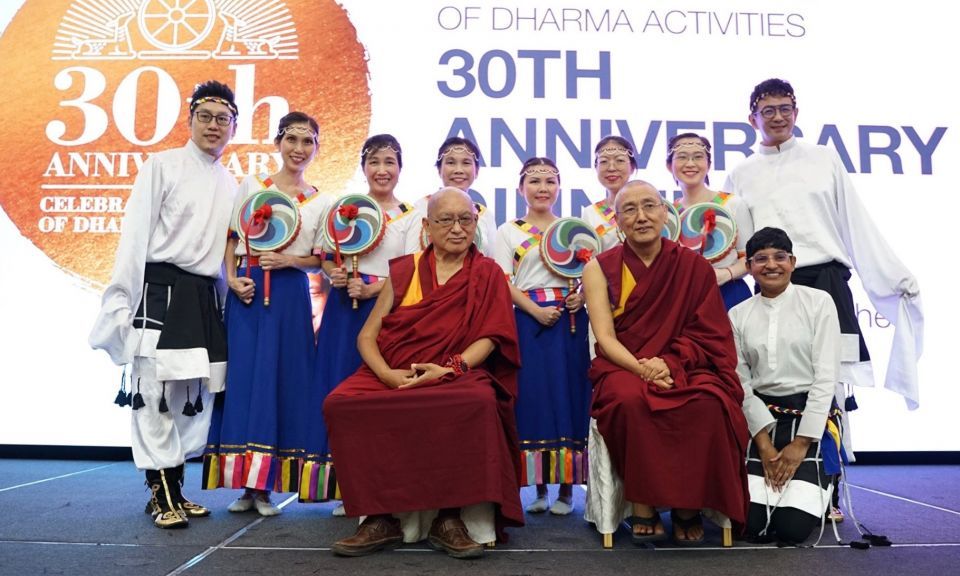
Lama Zopa Rinpoche and FPMT resident geshe Khen Rinpoche Geshe Thubten Chonyi with the traditional Tibetan drum dance performers at Amitabha Buddhist Centre’s 30th anniversary dinner, Jubilee Garden Restaurant at SAFRA Club, Singapore, September 2019. Photo courtesy of Amitabha Buddhist Centre.
On Friday, September 20, 2019, Amitabha Buddhist Centre, the FPMT center in Singapore, celebrated the center’s 30th birthday at an evening celebration with Lama Zopa Rinpoche as their guest of honor. Lobsang Drolkar (Cecilia Tsong), a long-time student, active ABC member, and volunteer shares the story about Rinpoche’s visit to Singapore and the celebration.
Amitahba Buddhist Centre (ABC) can be said to be one of the most fortunate centers in the FPMT family in that we have been blessed to be able to host Lama Zopa Rinpoche on almost a yearly basis. Just as Rinpoche had graced our 25th anniversary celebrations, so now on our 30th birthday, our most precious Guru was here to celebrate this most happy of occasions with us again.
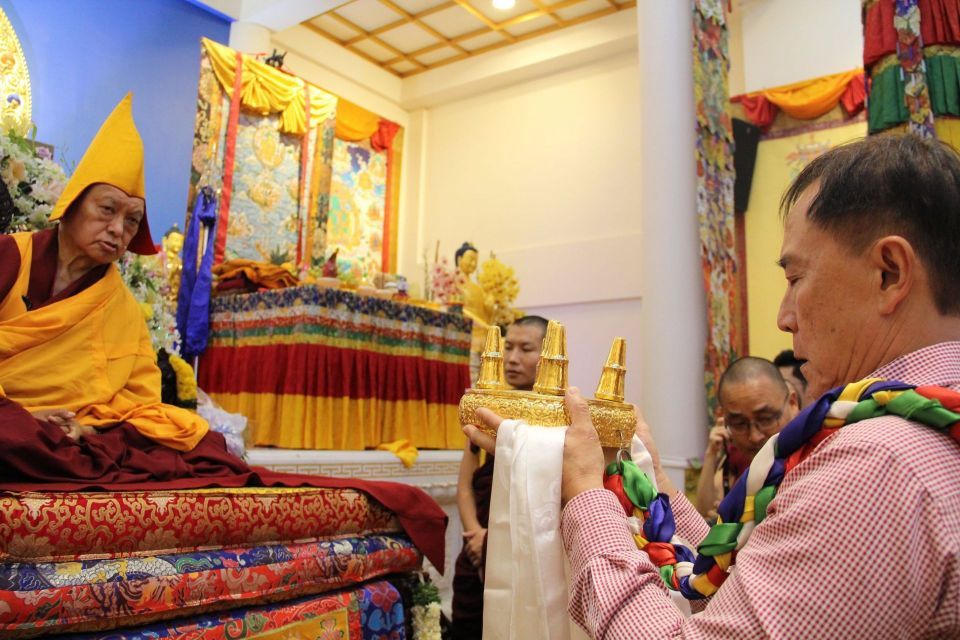
Center director Tan Hup Cheng offering the mandala to Lama Zopa Rinpoche, Amitabha Buddhist Centre, Singapore, September 2019. Photo courtesy of Amitabha Buddhist Centre.
Much has transpired over the last five years. In accordance with Rinpoche’s extensive advice, the twelve-foot (3.7-meter) high Chenrezig statue was commissioned and completed. A traditional Tibetan style gateway was constructed at the main entrance. It was painstakingly decorated with specially chosen mantras and Buddhist symbols as advised by Rinpoche. And prior to Rinpoche’s visit last year, after thirty long years, Amitabha Buddhist Centre was finally graced with a stunning Amitabha Buddha statue flanked by a pair of dragons at its gateway.
Watch the video “Our ABC 2019,” commemorating ABC’s 30th anniversary on YouTube:
https://youtu.be/4AgHK7pS6U8
Rinpoche’s blessings began with an unexpected early arrival. Rinpoche offered many additional teachings, an extensive commentary on Lama Chopa (Guru Puja), and initiations and empowerments that were not announced earlier. Rinpoche conferred a special jenang of Vajrapani Hayagriva and Garuda, and prior to the long life puja Rinpoche conferred a White Tara initiation. In addition, in response to the unrest in Hong Kong, a group recitation of the Gyaltsen Sema Punkyen was organized.
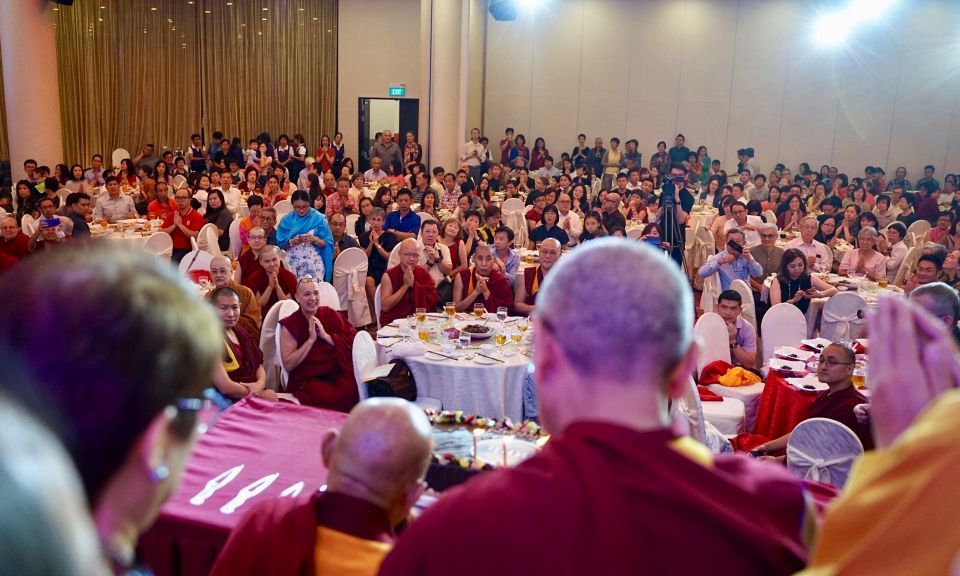
Amitabha Buddhist Centre’s 30th anniversary dinner, Jubilee Garden Restaurant at SAFRA Club, Singapore, September 2019. Photo courtesy of Amitabha Buddhist Centre.
The highlight of the celebrations was a special 30th anniversary dinner. Our very own Ven. Tenzin Tsultrim had compiled a special commemorative video that contained much archival material of ABC’s earliest beginnings. Those present had much fun trying to identify senior students during their salad days! Not only was the video nostalgic for the old timers, but it showed how far ABC has come in the last three decades.
Watch the video “Look Back & Celebrate!” on YouTube:
https://youtu.be/R9ghQETWZq0
In addition, there was live entertainment in the form of dance performances by the adorable little children from ABC’s childcare center, vocal performances by ABC’s very own choral group, Mudita, and a very well-received traditional Tibetan drum dance performed by ABC members and staff, who had rehearsed tirelessly for the past five months. To commemorate the occasion, all those present were given a specially designed hand-held prayer wheel.
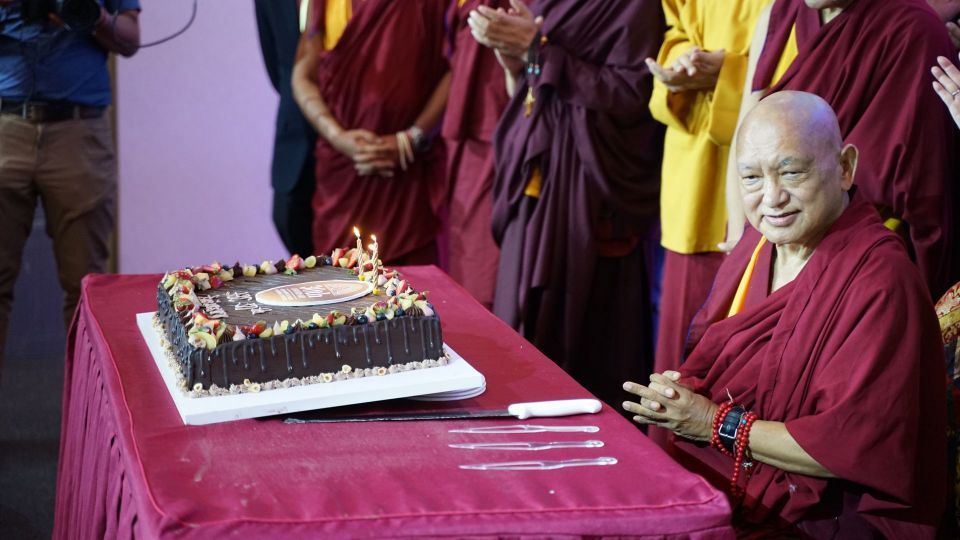
Lama Zopa Rinpoche at Amitabha Buddhist Centre’s 30th anniversary dinner, Jubilee Garden Restaurant at SAFRA Club, Singapore, September 2019. Photo by Tan Seow Kheng.
To learn more about Amitabha Buddhist Centre visit their website:
http://www.fpmtabc.org
FPMT.org and Mandala Publications brings you news of Lama Zopa Rinpoche and of activities, teachings, and events from over 160 FPMT centers, projects, and services around the globe. If you like what you read, consider becoming a Friend of FPMT, which supports our work.
- Tagged: amitabha buddhist centre, anniversary, cecilia tsong, geshe thubten chonyi, khen rinpoche geshe chonyi, lama zopa rinpoche, singapore, tan hup cheng
12

Drilbu Ri, Lahaul Spiti district, Himachal Pradesh, India, August 2019. Photo courtesy of Tushita Meditation Centre.
FPMT resident teacher, staff members, and volunteers at Tushita Meditation Centre, the FPMT center in Dharamsala, Himachal Pradesh, India, went on pilgrimage to Lahaul (Garsha) in August 2019. The group traveled together in the Tushita bus and two additional vehicles on a route which included crossing the Rohtang Pass on the Leh-Manali Highway from Kullu district to the Lahaul Spiti district in Himachal Pradesh. Ven. Tenzin Kunphen, spiritual program coordinator, and Maria Nobuko Corrales, creative project assistant, share the story. This is a short excerpt from the published online story, “Tushita Meditation Centre Staff Went on a Pilgrimage to the Land of Dakinis.”
In August 2019, the Tushita staff did something remarkable following Lama Zopa Rinpoche’s advice. We closed our doors for a week and went on pilgrimage together! Our destination was Garsha, the Land of Dakinis (also know as Lahaul), in northern Himachal Pradesh, India. This spiritual adventure was filled with both trying and recurring obstacles that threatened our safety and caused some to turn back, but it was also filled with powerful blessings for those who endured!
This wasn’t the first time Tushita staff had traveled to Lahaul. In 2013, we were blessed to be invited by Lama Zopa Rinpoche to visit Lahaul, where Rinpoche did a private retreat in Triloknath together with Tsenshap Serkong Rinpoche and Khadro-la (Rangjung Neljorma Khadro Namsel Drönme). Tushita staff traveled with Rinpoche for two weeks. Then in 2015, following Rinpoche’s advice, the Tushita team went on pilgrimage for the first time, making a one-week pilgrimage to Lahaul.
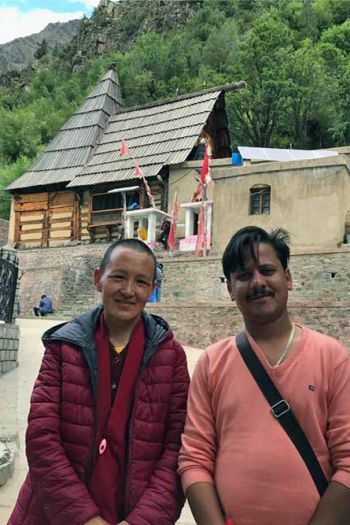
Markula temple, Udaipur, Lahaul Spiti district, Himachal Pradesh, India, August 2019. Photo courtesy of Tushita Meditation Centre.
In August 2019, our primary pilgrimage destinations were:
- Drilbu Ri Mountain—revered Chakrasamvara mountain, Palace of the Buddha’s Enlightened Body
- Phakpa Temple in Triloknath—revered Chenrezig statue and the Milky Chenrezig Lake (Omay Tso), Palace of the Buddha’s Enlightened Speech
- Markula Temple in Udaipur—revered Vajravarahi temple, Palace of the Buddha’s Enlightened Mind
On the way we visited:
- Sangam—the spot where the Chandra and Bhaga Rivers meet and unite together as Chandrabhaga River
- Tara Temple and Palden Lhamo waterfall near Sissu
- Padmasambhava caves and statue in Rewalsar (Tso Pema)
At 10 P.M. on August 18, nineteen of Tushita’s staff and volunteers loaded up into a bus and two additional vehicles to begin our long overnight drive to our first waypoint: Manali. Ginger tablets and Dramamine were washed down, strategically timed, along with prayers for effectiveness by those pilgrims susceptible to the destabilizing effect of the twists and turns promised by the road ahead. The hours of winding roads lived up to their reputation as a few meals reversed course, never completing their digestion, and others barely held on.
In the early still-dark hours of the next morning, just outside of Manali, we came to a halt. We were faced with a two-lane road that had crumbled to less than one, washed away by the heavy rains into the river below. Vinod, Tushita’s trusted driver who manned one of the vehicles, assessed the situation, uncertain if we could make it across. With a nagging feeling telling him “no” he reluctantly backed off, allowing the car that had come up behind us to make their choice.
As this new vehicle asserted its confidence in forging ahead, we all felt a wave of both relief and empathy as the car became stuck precisely where Vinod had a bad feeling. Reversing and attempting two hour-long detours before finally finding an alternate way through, all three Tushita cars reconvened in the light of a new day in Manali. …
Read the full online story, “Tushita Meditation Centre Staff Went on a Pilgrimage to the Land of Dakinis,” and view more photos online:
https://fpmt.org/mandala/in-depth-stories/tushita-meditation-centre-staff-go-on-pilgrimage/
For information about Tushita Meditation Centre, visit their website:
http://tushita.info
FPMT.org and Mandala Publications brings you news of Lama Zopa Rinpoche and of activities, teachings, and events from over 160 FPMT centers, projects, and services around the globe. If you like what you read, consider becoming a Friend of FPMT, which supports our work.
11
Wishing Tenzin Ösel Hita a Happy Birthday!
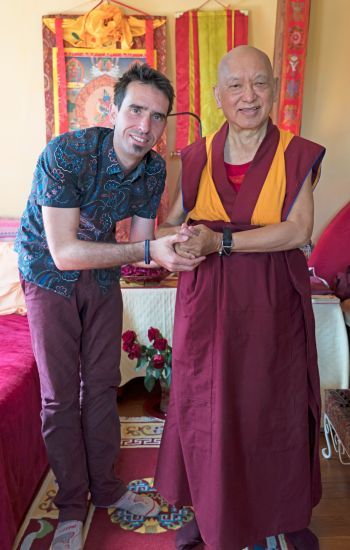
Tenzin Osel Hita and Lama Zopa Rinpoche, Institut Vajra Yogini, France, June 2019. Photo by Ven. Lobsang Sherab.
FPMT International Office wishes Tenzin Ösel Hita a very happy birthday and a long, healthy life. May his beneficial activities flourish and wishes come instantly into fruition!
Tenzin Ösel Hita, the recognized reincarnation of FPMT founder Lama Yeshe, turns 35 on February 12, 2020.
During the past year, Osel gave several talks at FPMT centers. Osel visited centers in the Bay Area of California and Florida in the United States, as well as in Italy and the United Kingdom.
Osel also attended teachings with Lama Zopa Rinpoche in Spain and France during the past year.
You can follow news and updates about Ösel on the Tenzin Ösel Hita news feed. Find recordings of talks by Ösel on the Tenzin Ösel Hita Videos page.
The Big Love Fund provides financial resources that enable Ösel to continue his endeavors on behalf of FPMT.
Find out more about Osel and his projects on his website:
https://one-big-love.com/
- Tagged: big love fund, tenzin osel hita
5

Panelists Colin Wiese, Bahá’í; Geshe Tenzin Zopa, Buddhism; Melanie Baulch, Quaker; Toni Coleman, moderator; Dr. Ata-ur Rehman, Islam; Rev’d Karen Kime, Aboriginal and Torres Strait Islander; Gaurav Bodar, Hinduism; Rev’d Gavin Krebs, Christianity in the Wagga Wagga City Council Chambers Meeting Room, New South Wales, Australia, August 2019. Photo by BAPS Swaminarayan Sanstha Wagga volunteers.
Approximately seventy community members gathered together at the Wagga Wagga City Council Chambers Meeting Room in Wagga Wagga, New South Wales, Australia, in August, for an interfaith event, “End-of-Life Care: A Multifaith Conversation,” organized by Potowa Study Group, the FPMT study group in Wagga Wagga. Interfaith activities are one of FPMT’s five pillars of service. Peir Woon, Potowa Study Group coordinator, shares the story.
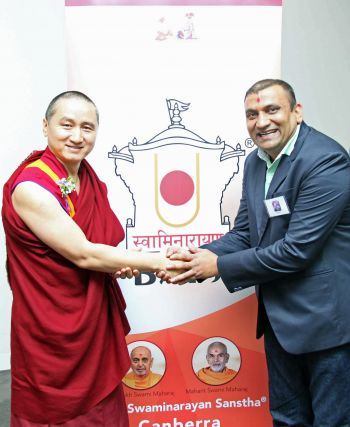
Geshe Tenzin Zopa and Mr. Dipak Gondaliya, BAPS Swaminarayan Sanstha Wagga representative, Wagga Wagga City Council Chambers Meeting Room, New South Wales, Australia, August 2019. Photo by BAPS Swaminarayan Sanstha Wagga volunteers.
Potowa Study Group organized a multifaith conversation entitled “End-of-life Care: A Multifaith Conversation” in Wagga Wagga, New South Wales, Australia. The event, held on August 3, 2019, was organized in conjunction with Dying to Know Day, an annual event aimed at improving the death literacy of people in Australia. Dying to Know Day was founded by The GroundSwell Project, an Australian-based non-profit organization.
This multifaith event was the second of its kind organized by Potowa Study Group; the first one was held in 2017. The 2019 event featured an impressive panel of speakers representing the following communities: Aboriginal and Torres Strait Islander, Bahá’í, Buddhist, Christian, Hindu, Muslim, and Quaker. The Buddhist community was represented by one of our dear FPMT teachers, Geshe Tenzin Zopa, who played an instrumental role in initiating the idea of having multifaith conversations locally.
Despite being a small city with a population of about 60,000, multiculturalism and multifaith groups are very prominent in Wagga Wagga. This creates an opportunity for multifaith dialogues, something we recognized especially after Geshe Zopa’s visit to Potowa Study Group back in November 2016.
The annual multifaith event began with participation from four faith groups back in 2017. By 2019 this had grown to seven groups. All the faith groups showed enormous support for having such multifaith discussion on various topics. This is one of the key strengths offered by Wagga Wagga city, which provides a harmonious and peaceful environment for a multi-ethnic and multifaith community.
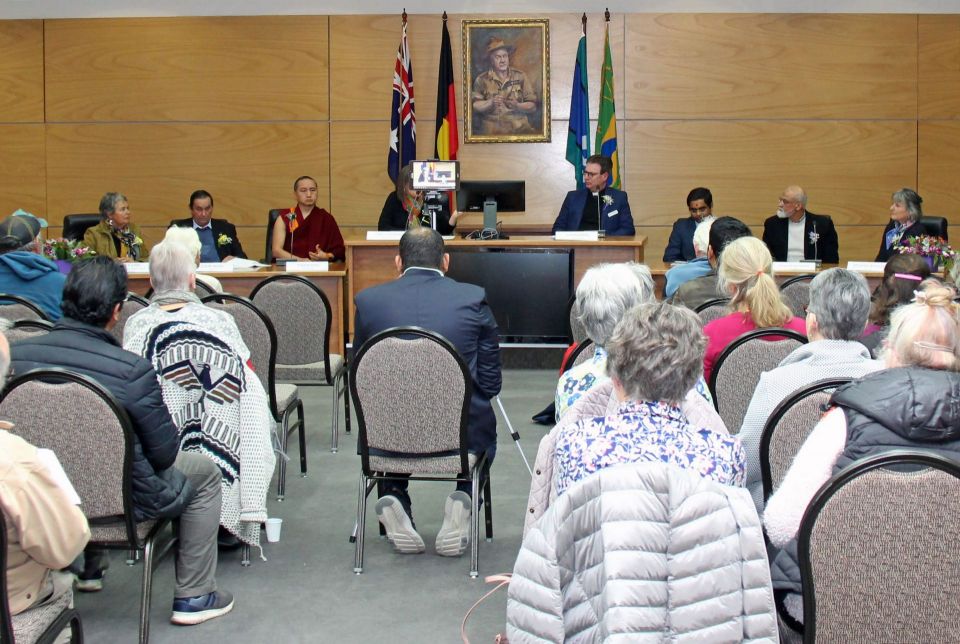
“End-of-life Care: A Multi-faith Conversation” in the Wagga Wagga City Council Chambers Meeting Room, New South Wales, Australia, August 2019. Photo by BAPS Swaminarayan Sanstha Wagga volunteers.
In 2019, the multifaith conversation was run in an entirely question and answer style format moderated by a palliative care specialist. Approximately seventy people from all walks of life attended the event in person, and another seventy watched the live-streamed event on our multifaith Facebook page, Our Common Word – Harmony Through Unity.
An analysis of our post-event survey shows that attendees enjoyed hearing from the diverse panel of speakers, who they found very interesting, and that all of the speakers spoke extremely well about death, dying, and bereavement. The event received positive feedback for the harmony it created between religious communities, with attendees noting that having such a broad range of religions and cultural groups coming together for this event really reinforced the sense that we can be united and we can live together. Many were surprised by how many things the different religions have in common, and attendees encourage the community to listen to the things that are eternal. Overall the event was a great success. The audience was extremely engaged for the duration of the two-hour event.
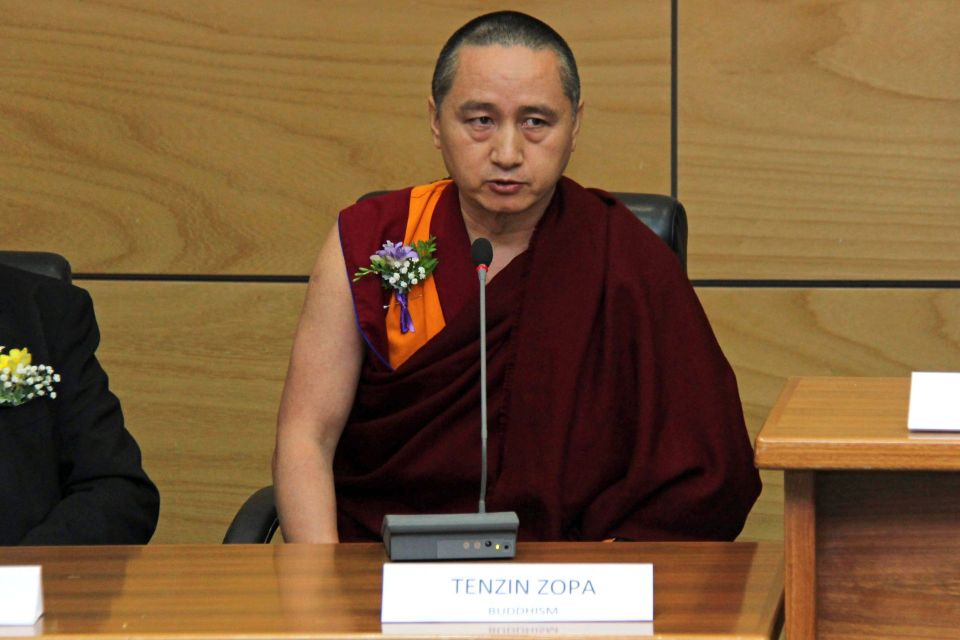
Geshe Tenzin Zopa speaking on the panel in the Wagga Wagga City Council Chambers Meeting Room, New South Wales, Australia, August 2019. Photo by BAPS Swaminarayan Sanstha Wagga volunteers.
The success of this event was due to the support we received from the Multicultural Council of Wagga Wagga, a local community group, and Murrumbidgee Primary Health Network, a local government agency, as well as the speakers and faith community groups.
Potowa Study Group is honored to be part of this meaningful annual event and will strive to continue to offer a similar service to the local community in the future. The next multifaith event, planned for mid-2020, will be focused on the theme of environment and sustainability.
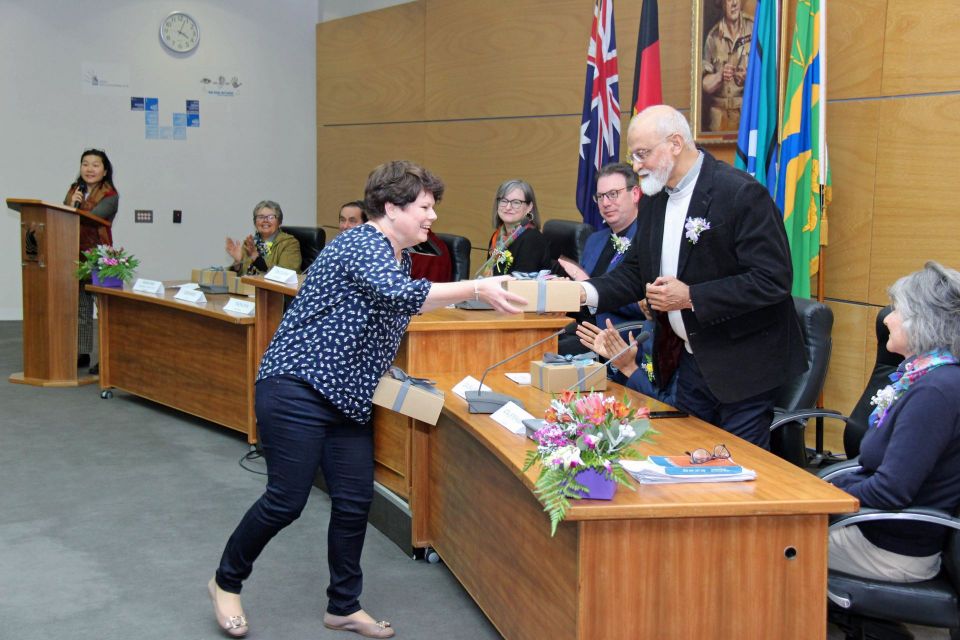
Stacey Heer, Murrumbidgee Primary Health Network project manager thanking Dr. Ata-ur Rehman in the Wagga Wagga City Council Chambers Meeting Room, New South Wales, Australia, August 2019. Photo by BAPS Swaminarayan Sanstha Wagga volunteers.
UPDATE—On February 23, 2020, Rotary Peace Day, Peir Woon was awarded the Rotary Club Award for Community Service by the Combined Rotary Clubs of Wagga Wagga’s Peace Community Committee as a representative of the Potowa Study Group in recognition of the multifaith dialogues the group has organized for the Wagga Wagga community since 2017.
For more information about Potowa Study Group, visit their website:
http://potowabuddhistgroup.simplesite.com/
Watch recordings of the “End-of-Life Care: A Multifaith Conversation” event on Facebook:
https://www.facebook.com/groups/262934810779443/videos/
For advice on death and dying, visit:
https://fpmt.org/death/
FPMT.org and Mandala Publications brings you news of Lama Zopa Rinpoche and of activities, teachings, and events from over 160 FPMT centers, projects, and services around the globe. If you like what you read, consider becoming a Friend of FPMT, which supports our work.
29
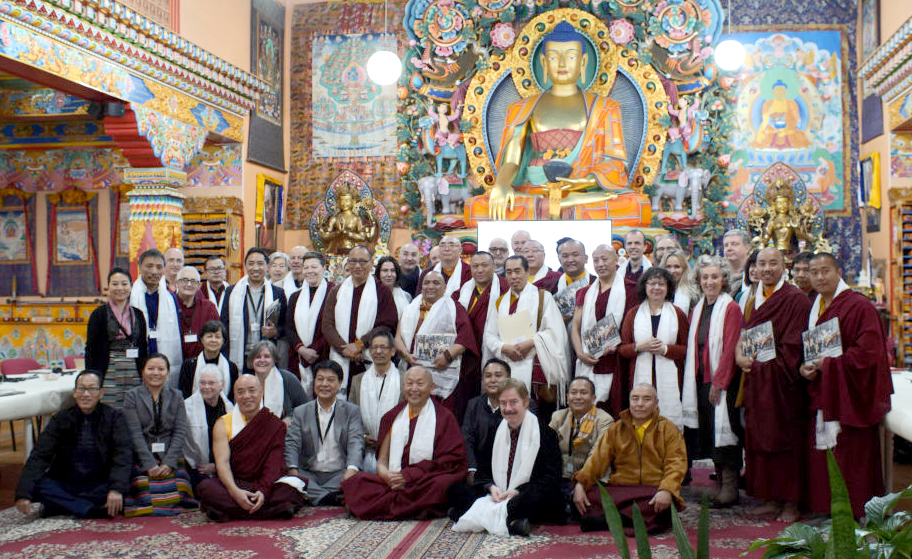
Participants in the Third European Tibetan Buddhism Conference, December 2019. Photo courtesy of Tibet.net.
The Third European Tibetan Buddhism Conference met in December 2019 on the issue of how the reincarnation of His Holiness the Dalai Lama will be identified. In the January 2020 FPMT Europe Newsletter, Paula De Wijs, director of Maitreya Instituut Amsterdam, wrote about the meeting, which she attended. Here’s a summary of her report:
On December 7–8, 2019, representatives of six FPMT centers in Europe participated in the Third Europe Tibetan Buddhism Conference. This meeting was organized by the Offices of Tibet with the aim of creating a European declaration on the issue of the reincarnation of the His Holiness the Dalai Lama.
The meeting was held in Yeunten Ling, a Kagyu center in Huy, Belgium. More than thirty participants from ten countries attended. At the end of the conference all present signed a three-point declaration, which stated that His Holiness the Dalai Lama and the officers representing him, specifically the Gaden Phodrang Trust, have the “sole power and responsibility” in matters concerning the recognition of the reincarnation of the Dalai Lama.
Organizers called the conference because the Chinese government already has measures in place to control the choosing of the reincarnation of His Holiness the Dalai Lama and other Tibetan Buddhist teachers. China’s State Religious Affairs Bureau Order Number 5 regulates the recognition and training of reincarnations and is being implemented.
These measures go against the wishes of His Holiness, the Tibetan people, and the Tibetan Buddhist community. In addition, having the Chinese government manipulate the Tibetan Buddhist traditions in this way concerns not only Tibetan Buddhists in Tibet, but also could have an impact on the transmission of Tibetan Buddhism outside of Tibet, including in the West.
His Holiness has stated in clear terms that he will choose where and how he will reincarnate. In a September 24, 2011, statement on DalaiLama.com titled “Reincarnation,” His Holiness outlines many aspects of reincarnation and the procedure that is to be followed to find his successor. All attending the conference fully support His Holiness in this, while praying that it will not be necessary to put these procedures into place for many years to come.
Conference delegates left the meeting with the task of making this situation known to students at their respective Dharma centers and in the Dharma communities in their areas or countries. And wherever possible, European government officials will be apprised of the situation.
The US government has already declared that they would not accept a successor to the Dalai Lama put forward by the Chinese government. The Dutch government has done the same. Conference attendants look forward to other European governments following suit. Local Offices of Tibet are available to provide further information on this subject.
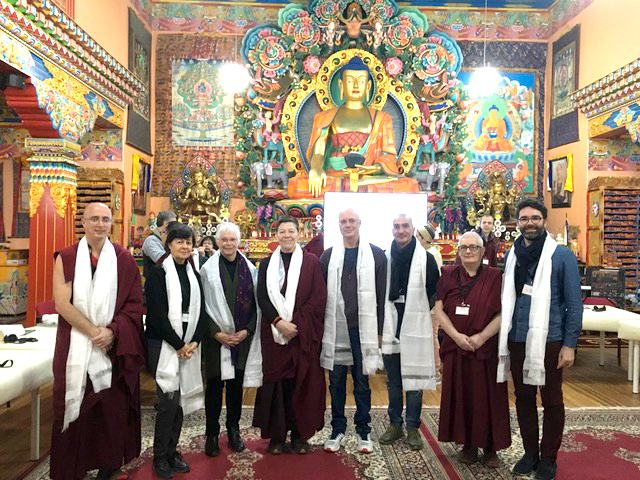
The FPMT delegation at the Third European Tibetan Buddhist Conference (from left): Ven. Gyaltsen, Teresa Fabbris, Paula de Wijs, Ven. Elisabeth Drukier, Nicolas Brun, Marco Parolin, Ven. Marga Echezarreta, and Carlo Casetti Brach; Huy, Belgium, December 2019. Photo courtesy of Paula de Wijs.
The declaration signed at the Third European Tibetan Buddhism Conference can be found here:
https://tibet.net/3rd-europe-tibetan-buddhism-conference-in-belgium-adopts-3-point-declaration-on-the-reincarnation-of-the-dalai-lama/
For more, you can also read about the November 2019 declaration “14th Tibetan Religious Conference affirms the Dalai Lama’s sole authority in his reincarnation, condemning China’s meddling in religious affairs” here:
https://tibet.net/14th-tibetan-religious-conference-affirms-the-dalai-lamas-sole-authority-in-his-reincarnation-illigitimises-chinas-meddling-in-religious-affairs/
FPMT.org and Mandala Publications brings you news of Lama Zopa Rinpoche and of activities, teachings, and events from over 160 FPMT centers, projects, and services around the globe. If you like what you read, consider becoming a Friend of FPMT, which supports our work.
22
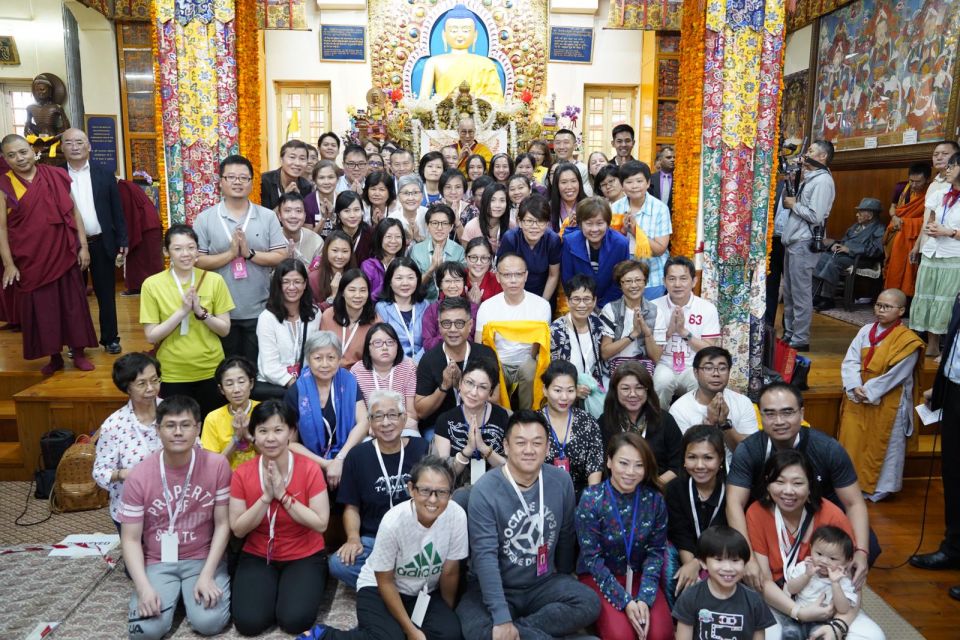
His Holiness the Dalai Lama with Amitabha Buddhist Centre students, Dharamsala, India, September 2019. Photo courtesy of Amitabha Buddhist Centre.
Amitabha Buddhist Centre (ABC), the FPMT center in Singapore, organized a tour to India from August 31-September 8, 2019. The highlight of the tour was His Holiness the Dalai Lama’s public teachings given at Tsuglagkhang (the main Tibetan temple) in Dharamsala, India, at the request of a group from Asia. His Holiness gave morning teachings from September 4-6 on The Four Noble Truths and their Sixteen Characteristics (denpa shi, mitak sok chudruk), The Thirty-Seven Factors of Enlightenment (jangchok sodun), and Nagarjuna’s Commentary on the Awakening Mind. Approximately 6,500 people—including 2,000 visitors from sixty-nine countries, of which 855 were from thirty-eight Asian groups—attended the teachings. Lobsang Drolkar (Cecilia Tsong), a long-time student, active ABC member, and volunteer shares the story.
Ever since the start of the series of teachings for Asian students in Dharamsala over ten years ago, except for 2018, Amitabha Buddhist Centre has been organizing trips to these teachings in September every year without fail. The center director, Tan Hup Cheng, feels strongly that the center must do what it can to enable newcomers to the Dharma to make this most precious of connections with His Holiness the Dalai Lama. So notwithstanding his crazy busy schedule, Hup Cheng has made it a point to lead these trips himself.
And so it was planned for 2019, until Lama Zopa Rinpoche suddenly decided to arrive in Singapore almost two weeks earlier than the original scheduled date. As a result, Hup Cheng could no longer lead the trip. Fortunately, a senior student, Phuah Soon Ek, who was very experienced in leading such trips, stepped up to the plate.
In 2019, there was a group of thirty-four participants, most of whom have never been to India or met His Holiness before. Our youngest pilgrim was an eleven-year-old boy! As in the past, before the teachings we traveled with some hardship to Tso Pema, the holy lake associated with Guru Rinpoche. Once everyone visited all the holy caves where Guru Rinpoche practiced, all tiredness was forgotten as we did prayers and soaked up the blessings of Guru Rinpoche.
The following day was the visit to our sister center in Dharamsala, Tushita Meditation Centre, where we had the chance to visit Lama Zopa Rinpoche’s private rooms, now further expanded with a new extension. The highlight was the visit to Lama Yeshe’s room—preserved intact with all his belongings—and the opportunity to make prostrations and offerings at his meditation seat, praying that one day, may we become just like him.
The teaching program was most suitable for our group as His Holiness taught the Four Noble Truths and their Sixteen Characteristics, the Thirty-Seven Factors of Enlightenment, and gave a commentary on Nagarjuna’s Commentary on the Awakening Mind—all foundational topics that will stand us in good stead as we embark on our Dharma studies.
In the past few years, participants have also been granted special access to His Holiness’ private gompa, which houses countless holy objects. One of the most precious of these is the body relic of his senior tutor, His Eminence the Sixth Kyabje Ling Rinpoche. By happy coincidence, on the very same day as our gompa visit, in the afternoon, we were privileged to have an audience with the present His Eminence the Seventh Kyabje Ling Rinpoche at Rinpoche’s residence.
So, within the short span of slightly over a week we experienced both the power of the Dharma as expounded by His Holiness, and saw for ourselves the power of Dharma practice in the palpable energy of Guru Rinpoche and meeting the reincarnation of H.E. Ling Rinpoche.
To learn more about Amitabha Buddhist Centre visit their website:
http://www.fpmtabc.org
Watch His Holiness’s September 4-6, 2019, teachings on YouTube:
https://youtu.be/71HAhhcrAQw
https://youtu.be/3tXSS_gzCFk
https://youtu.be/qDavXnPPk9A
FPMT.org and Mandala Publications brings you news of Lama Zopa Rinpoche and of activities, teachings, and events from over 160 FPMT centers, projects, and services around the globe. If you like what you read, consider becoming a Friend of FPMT, which supports our work.
- Tagged: amitabha buddhist centre, cecilia tsong, dalai lama, dharamsala, his holiness the dalai lama, kyabje ling rinpoche, tan hup cheng, tso pema, tushita meditation centre
21

Smoke from the ongoing bushfires in Australia as seen from the International Space Station, January 4, 2020. Photo by NASA ISS, public domain. (Source: https://eol.jsc.nasa.gov/SearchPhotos/photo.pl?mission=ISS061&roll=E&frame=120235)
The ongoing bushfires in Australia are devastating many areas throughout the country, affecting humans as well as billions of insects and animals.
FPMT Australia (FPMTA) has created a new webpage, “Bushfires Across Australia,” with news on the bushfires and on their impact on humans and animals, updates on FPMT centers directly affected by the fires, advice for practices to do, and information on how you can help.
“We have been overwhelmed at the outpouring of compassion and the desire to help that has come from across the globe,” FPMTA writes. “This, coupled with local communities’ and individual’s support and care for each other, has been a source of great emotional comfort at a time of huge loss, fear, and anxiety. FPMT in Australia has been deluged with people wishing to help in practical ways and through prayers and practices.”
Recommended practices that can be done to help dispel bushfires can be found in Lama Zopa Rinpoche’s collection of advice for natural disasters on FPMT.org and on the Lama Yeshe Wisdom Archive page “Practices for Natural Disasters.” If you are under threat of bushfire or natural disaster, you can recite “Prayer to Guru Rinpoche to Clear Away Obstacles on the Path.”
FPMTA shared the following about the hardest hit FPMT center:
“FPMT’s De-tong Ling Retreat Centre (DTL) on Kangaroo Island, in the state of South Australia, has suffered greatly from the impact of the fires. DTL was saved, but the neighbous who helped fight the blaze, some protecting DTL, weren’t so lucky – many lost their homes. Fires on the island had been burning for four weeks and intensified, claiming two lives. The total area destroyed by the Kangaroo Island bushfires now stands at more than 200,000 hectares, which is almost half the island. Wildlife such as bees, the endangered glossy-tailed cockatoo and dunnart marsupial are feared to become extinct, and 30,000 koalas are believed to have been killed.”
For more, including how to help, visit FPMT Australia’s “Bushfires Across Australia” page:
http://fpmta.org.au/bushfires-across-australia/
FPMT.org and Mandala Publications brings you news of Lama Zopa Rinpoche and of activities, teachings, and events from over 160 FPMT centers, projects, and services around the globe. If you like what you read, consider becoming a Friend of FPMT, which supports our work.
- Tagged: australia, fire, fpmta, natural disasters
17
Welcome to Our January e-News
In the January FPMT International Office e-News, we bring you news about:
- The Official Long Life Puja for Lama Zopa Rinpoche
- Rejoicing in Another Year of Animal Liberation
- A New Translation of the FPMT Ethical Policy
…and more!
Have the e-News translated into your native language by using our convenient translation facility located on the right-hand side of the page.
The FPMT International Office e-News comes from your FPMT International Office. Visit our subscribe page to receive the FPMT International Office News directly in your email box.
15
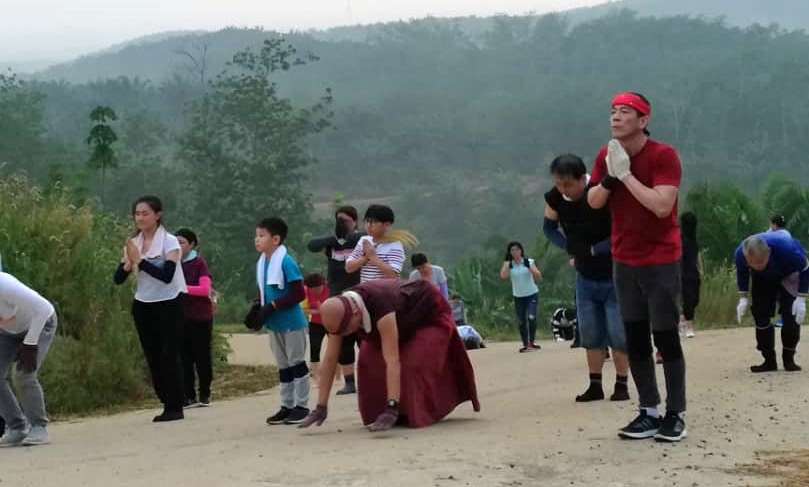
Prostrations at Rinchen Jangsem Ling Retreat Centre, Triang, Malaysia, August 2019. Photo courtesy of Rinchen Jangsem Ling Retreat Centre.
On August 25, 2019, a large prostration event took place at Rinchen Jangsem Ling Retreat Centre, the FPMT center in Triang, Malaysia. FPMT Southeast Asia regional coordinator, Selina Foong, shares the story. This is a short excerpt from Selina’s published online story, Prostrating Up a Hill at Rinchen Jangsem Ling Retreat Centre in Malaysia.
I’ve made countless trips to beautiful Rinchen Jangsem Ling over the years. On previous trips the highlight was the arrival, not the journey. We’d be in our car chatting away, typically heading to an executive committee meeting or a retreat. The scenery would zip by, familiar but fleeting. A recent trip, however, could not have been any more different!
A few months earlier I had been pleasantly shocked to learn that a tour group from out of town had visited Rinchen Jangsem Ling and decided to organize an impromptu prostration event. (Often large groups of friends and acquaintances will visit Rinchen Jangsem Ling in large tour buses.) For every three steps they took they would prostrate once. And not just over a short distance, but all the way from the bottom of the hill up to the Rinchen Jangsem Ling gompa!

Prostrations at Rinchen Jangsem Ling Retreat Centre, Triang, Malaysia, August 2019. Photo courtesy of Rinchen Jangsem Ling Retreat Centre.
“Wow!” I marveled. That’s more than 1.2 kilometers (three quarters of a mile) on a variety of purification-inducing surfaces including red dirt, sharp loose gravel, and knee-punishing concrete! Throw in regular whiffs (not to mention actual patches) of cow dung. Add in the relentless tropical heat and high humidity. And top it off with the fact that many of these visitors were new to Rinchen Jangsem Ling and had not done even one prostration before, let alone 1.2 kilometers worth!
Incredibly, this impromptu prostration event turned out to be a huge hit. So much so that there were immediate calls for a repeat event. “Yes!” I thought. ”Here comes my own chance to burn off eons and eons of negative karma!” After all, Lama Zopa Rinpoche has taught us time and again about the effectiveness of doing prostrations with body, speech, and mind. And the more atoms of our bodies that are in contact with the ground when we prostrate, the better. What’s more, the higher the location of our prostrations, the better that would be too. (All the more atoms below us!)
Keen to take Rinpoche’s advice to heart, I had to nonetheless concede that my chances of prostrating all the way up to Mount Everest were rather slim. I could indeed, however, try to prostrate all the way up to Rinchen Jangsem Ling! And that was how I found myself at the base of the Rinchen Jangsem Ling hill one Sunday morning, standing in pitch darkness among the trees with Oi Loon Lee and several hundred others. Already sweating and tingling with anticipation, we were at the back of the huge crowd but could easily hear Rinchen Jangsem Ling’s center director, Ven. Sonam Yeshe, who was at the front leading the motivation and prayers on a loudspeaker. It all felt quite surreal. Then very slowly everyone started moving forward and the prostrating began. …
Read Selina’s full online story, “Prostrating Up a Hill at Rinchen Jangsem Ling Retreat Centre in Malaysia,” and view more photos online:
https://fpmt.org/mandala/in-depth-stories/prostrating-up-a-hill-at-rinchen-jangsem-ling-retreat-centre-in-malaysia/
For more information about Rinchen Jangsem Ling Center, visit their website:
http://www.jangsemling.com/
FPMT.org and Mandala Publications brings you news of Lama Zopa Rinpoche and of activities, teachings, and events from over 160 FPMT centers, projects, and services around the globe. If you like what you read, consider becoming a Friend of FPMT, which supports our work.
- Tagged: oi loon lee, prostrations, rinchen jangsem ling, selina foong
8

Tenzin Ösel Hita at Vajrapani Institute, Boulder Creek, California, US, August 2019. Photo by Liz Chisler.
Tenzin Ösel Hita, the recognized reincarnation of FPMT co-founder Lama Yeshe, visited California, US, in August 2019, touring the four FPMT Bay Area centers. Osel visited Vajrapani Institute in Boulder Creek, where he gave a talk and participated in the center’s Big Love Annual Community Celebration. Then he led a five-day retreat, “Being Your True Nature: A Meditation and Yoga ‘Being Experience,'” at Land of Medicine Buddha in Soquel. Ösel also gave public talks at Gyalwa Gyatso (Ocean of Compassion) Buddhist Center in Campbell and Tse Chen Ling in San Francisco. Heidi Oehler, Vajrapani Institute center director; Catherine Graham, Vajrapani Institute spiritual program coordinator; Urs von Matt, Ocean of Compassion center manager; and MaryEllen Kirkpatrick, Tse Chen Ling spiritual program coordinator, all contributed to this story.
A remarkable energy of harmony and open-heartedness permeated the air at Vajrapani Institute during the events Tenzin Ösel Hita attended in early August. Many older students of Lama Yeshe joined a handful of relative newcomers to connect with Lama’s reincarnation on Saturday, August 3. Some appeared to be visibly sparkling by the end of the day and many seemed deeply moved by Ösel’s presence.
Then on Sunday, August 4, more than a hundred people gathered around the Enlightenment Stupa at our “Big Love Day” annual summer festival, and soaked up the wisdom, honesty, and humor Ösel Hita shared with the crowd.
The day-long event held here on August 3 was created to offer a container for Ösel’s vision of creating “being” experiences for others. Attended by 32 people, the day’s theme was “Reconnecting with Your Authentic Nature and Healing into Wholeness.” Participants were led through a variety of meditation, yoga, movement, and self-expression activities. This prepared them for the day’s highlight: an afternoon talk delivered by Ösel, also attended by staff and community members.
Many present were struck by the courageous and deeply authentic way Ösel spoke, and some former students of Lama Yeshe’s remarked afterwards upon the uncanny similarities between some of Ösel’s comments and those Lama used to make.
Afterwards there was an opportunity to offer khatas. Ösel seemed to really enjoy connecting personally with everyone in this way, and the atmosphere was light and joyful. Ösel even needed a little prodding towards the end to persuade him to leave on time so as not to be too late for his next appointment!
Ösel returned the next day for Vajrapani’s “Big Love Day” festival. Once again his talk was a highlight of the day. At the end many lined up to meet him individually.
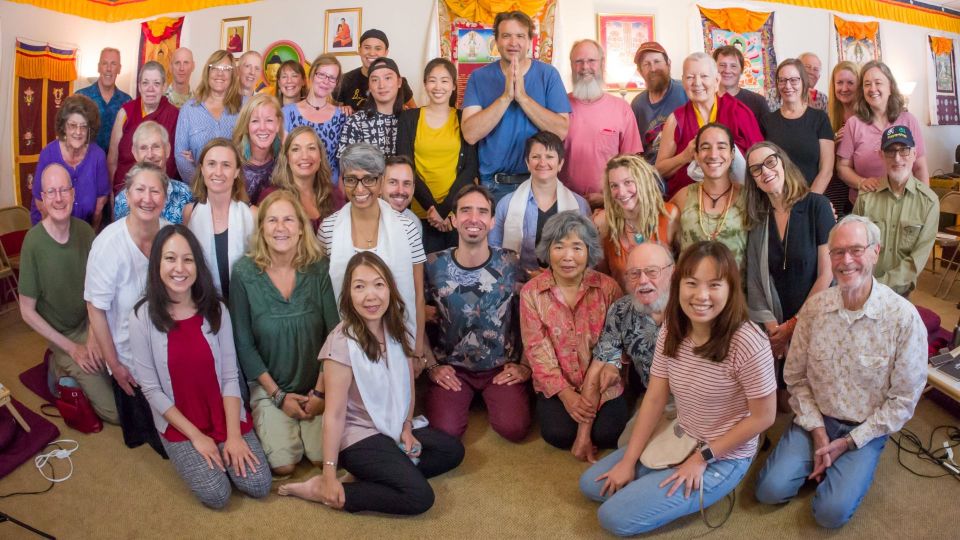
Tenzin Ösel Hita at Ocean of Compassion, Campbell, California, US, August 2019. Photo by Urs von Matt.
Ocean of Compassion Buddhist Center was honored to host Tenzin Ösel Hita during his inaugural Bay Area tour. His visit on Saturday, August 10, was arranged on very short notice, and thanks to the many volunteers we were able to take advantage of this unique opportunity. We were pleasantly surprised to see a lot of new faces at the center. It seems that many people were intrigued to see a young recognized reincarnation of a Tibetan lama.
Ösel was very happy to answer questions about his lineage and his place in the Buddhist world. Ösel showed a genuine humility. He gave hugs to people and made them feel welcome. We had to lower his teaching seat as he didn’t want to sit higher than the audience. Ösel was able to connect very well with people. He treated the event as a workshop and encouraged people to ask questions, acting as a bridge between Buddhist philosophy and the modern Western mind. The event was also live streamed on Facebook and reached a large worldwide audience.
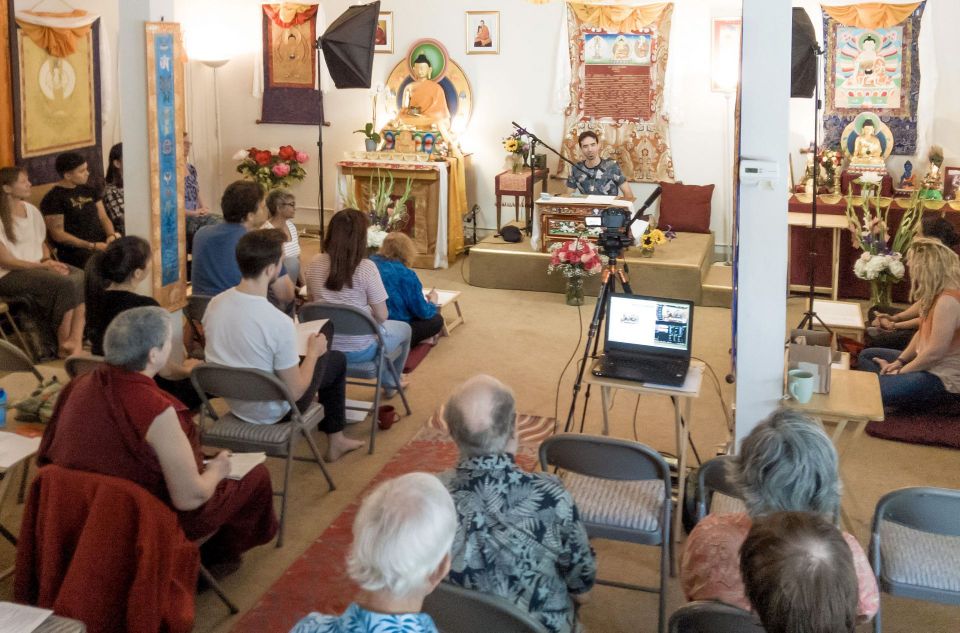
Tenzin Ösel Hita at Ocean of Compassion, Campbell, California, US, August 2019. Photo by Urs von Matt.
What a wonderful gift it was to have Ösel come to Tse Chen Ling on Sunday, August 11, and give a talk called “Taste of Buddhism: ‘One Big Love.'” Some people came because they had a personal connection with Lama Yeshe; some had a connection through familiarity with the archives of Lama Yeshe’s precious teachings; others were drawn to the charismatic presence of this young man, this “radical free thinker.”
Ösel pointed out that each of us has our own perspective, and from that place we project the world around us. He remarked that it has been a challenge for him to be able to differentiate between who he really is, what people have projected onto him, and who they expected him to be. He emphasized, “I am not going to fall into a box for you. I am not going to play your game.” Remarking that he was making himself very vulnerable, he encouraged us to really try to get to know him. Rather than delivering a Dharma talk Ösel asked the audience for questions, promising that he would do his best. He impressed on us that we should see him not as a lama but as a friend.
When someone asked about his needs and what we as a community could do to help him he responded that the best thing that we could do for him is to really put the Dharma into practice. Ösel described this as a lifestyle and personal responsibility. He encouraged us to follow the examples set by the holy beings in human form: our gurus His Holiness the Dalai Lama, Lama Zopa Rinpoche, and so on. We have to help ourselves and adapt the Dharma to our lives. We must put into practice what we are learning, and we should not separate learning and meditation. We must be aware and conscious.
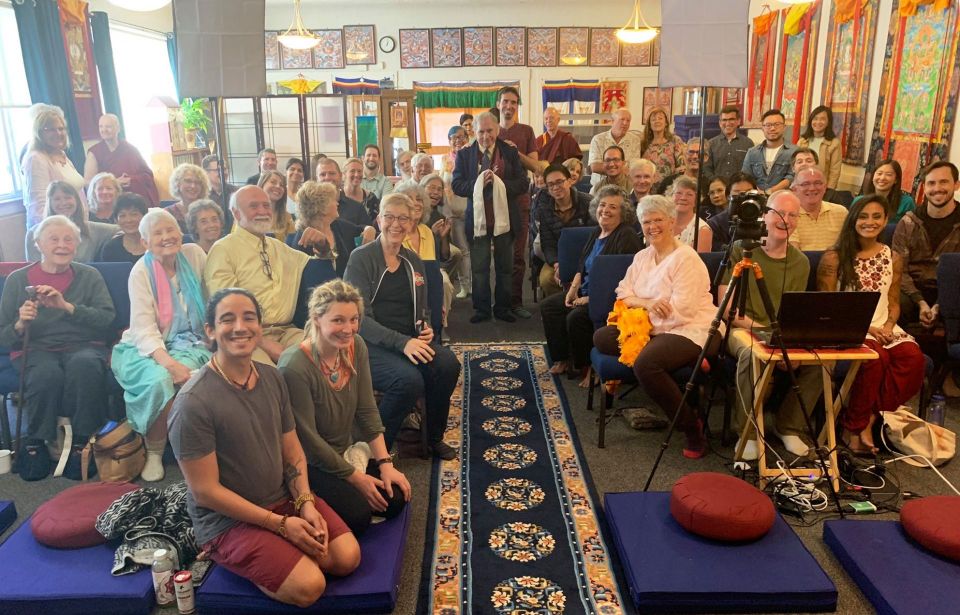
Tenzin Ösel Hita at Tse Chen Ling, San Francisco, California, US, August 2019. Photo courtesy of Tse Chen Ling.
He shared that what he studied in the monastery for nearly half of his life really helped him when he “dove head-first into samsara.” Ösel expressed that he sees Dharma as a lifestyle and ourselves as a process: “You are happening; you are being.” Without an active and dedicated commitment to confront ourselves, he compared the Dharma to a light bulb without electricity. “It’s about your own experience; you have to walk it.” He challenged us to share only the best of ourselves with others. Be patient with ourselves but be responsible. “Don’t follow your thoughts wherever they take you,” he said. Thinking “I have no choice is very cowardly.” We need to recognize that “circumstances don’t make us; we make the circumstances.”
At the end of the program Ösel recommended that if we just try to be kind, we will all be happier. He stood up and greeted us as we approached to say goodbye: embracing each of us in turn, seeing each of us, and not rushing.
Watch Tenzin Ösel Hita’s talk at Ocean of Compassion or listen to the audio recording:
https://www.gyalwagyatso.org/2019-08-10-tenzin-osel-hita.html
Watch Tenzin Ösel Hita’s talks at Vajrapani Institute:
https://youtu.be/Is1iG5DeY5g
https://youtu.be/pZWQ0w-5-T4
FPMT.org and Mandala Publications brings you news of Lama Zopa Rinpoche and of activities, teachings, and events fromover 160 FPMT centers, projects, and services around the globe. If you like what you read, consider becoming a Friend of FPMT, which supports our work.
- Tagged: catherine graham, gyalwa gyatso (ocean of compassion) buddhist center, heidi oehler, land of medicine buddha, maryellen kirkpatrick, tenzin osel hita, tse chen ling, urs von matt, vajrapani institute
1

Offering a mandala to H.E. Ling Rinpoche, Kopan Monastery, Nepal, October 2019. Photo by Geshe Thubten Jangchub.
Kopan Monastery welcomed His Eminence the Seventh Kyabje Ling Rinpoche in October 2019. Ani Fran (Ven. Fran Mohoupt) shared the story of H.E. Ling Rinpoche’s visit to the monastery in Nepal.
H.E. Ling Rinpoche’s visit to Kopan Monastery was short and delightful. Rinpoche arrived before lunch on Monday, October 21. Geshe Thubten Jangchub traveled with him from Pharping to Kathmandu. On arrival, Rinpoche was welcomed in the Kopan courtyard by all the monks and quite a few students from the course at that time. He then proceeded to the gompa for the ritual welcome offering of a body, speech, and mind mandala, prayers, and the traditional sweet rice and tea.
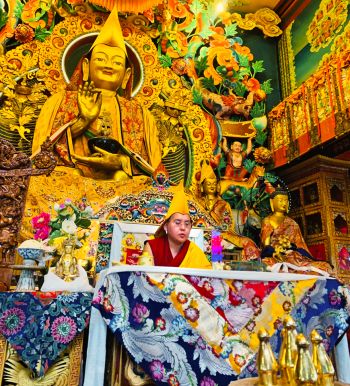
H.E. Ling Rinpoche teaching at Kopan Monastery, Nepal, October 2019. Photo by Geshe Thubten Jangchub.
In the afternoon, Rinpoche gave a teaching to the assembly of monks and nuns, which was the oral transmission and short commentary on the “Foundation of all Good Qualities.”
During a short tour of the monastery grounds in the late afternoon with the manager Tenpa Choden, Rinpoche commented on the beautiful environment, the pure air, and how conducive this was to study and practice.
Rinpoche very kindly accepted a request by the course coordinator to give a short talk and take questions from the students in the evening. There was much laughter and delight at the wonderful teaching Rinpoche gave on the fleeting nature of the sensations we experience moment by moment, and how we cling to these very momentary sensations as permanent. Rinpoche then took some questions from the audience, followed by a group photo.
Rinpoche left early the next morning, for a quick visit to the nunnery, Khachoe Ghakyil Ling, where he gave oral transmissions, and then to his next destination, Samten Ling and Shelkar Monastery in Boudhanath.
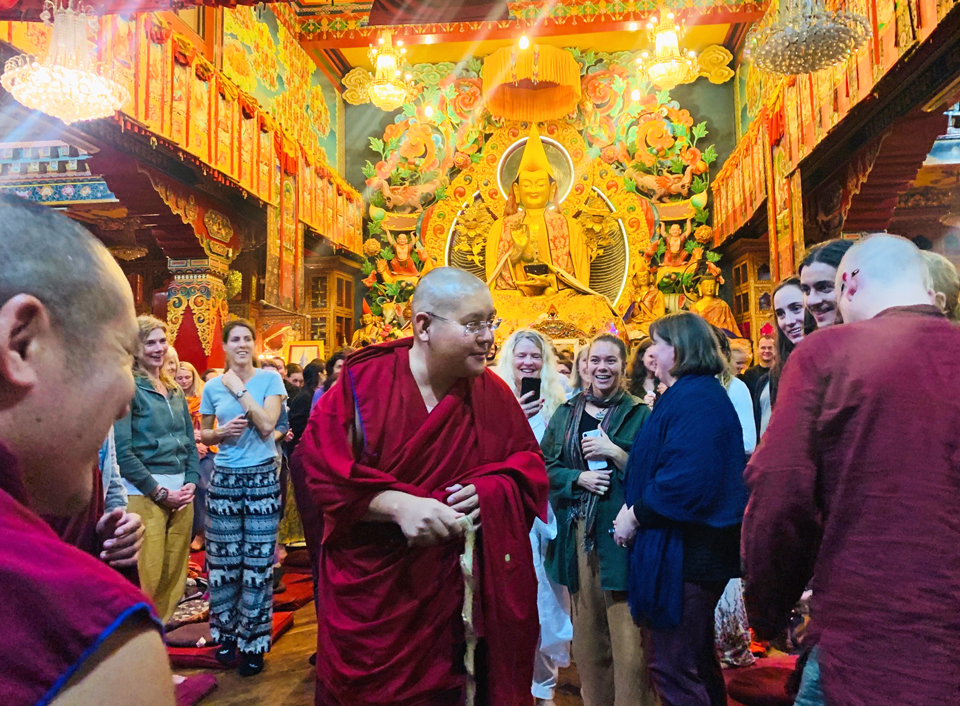
H.E. Ling Rinpoche in the gompa at Kopan Monastery, Nepal, October 2019. Photo by Geshe Thubten Jangchub.
For more information about H.E. Ling Rinpoche’s schedule, visit Rinpoche’s website:
http://lingrinpoche.info/
Learn about Kopan Monastery and the courses on Buddhism offered there:
https://kopanmonastery.com/
FPMT.org and Mandala Publications brings you news of Lama Zopa Rinpoche and of activities, teachings, and events from over 160 FPMT centers, projects, and services around the globe. If you like what you read, consider becoming a Friend of FPMT, which supports our work.
27
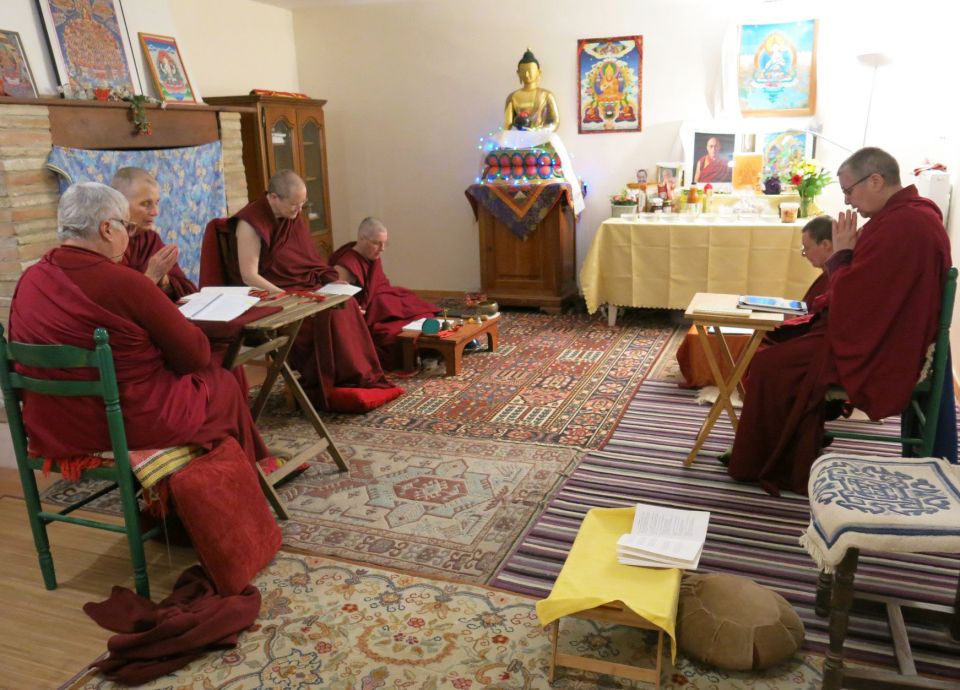
Vens. Thubten Tenzin, Tenzin Ngeunga, Tenzin Péma, Chantal Dekyi, Irene Turner, and Michèle Paldreun at Dorje Pamo Monastery, En Baut, Fiac, France, January 2018. Photo by Ven. Tsékyi.
Monastère Dorje Pamo (Dorje Pamo Monastery), an FPMT nunnery in En Baut, Fiac, France, welcomed Lama Zopa Rinpoche, as well as visiting and resident nuns, and volunteers in 2019. Ven. Chantal Tenzin Dekyi (Chantal Carrerot), coordinator, and Gabrielle Leflaive, volunteer, share the story.
In 2018 we finished the first phase of renovation work for Dorje Pamo Monastery, and rejoiced in the beginning of a monastic community life in En Baut, Fiac, France. Many events have taken place in the past few months. Most significantly, the monastery accommodated a dozen nuns who came for the Vajrayogini retreat with Lama Zopa Rinpoche held at nearby FPMT center Institut Vajra Yogini in May-June 2019. Dorje Pamo Monastery welcomed these nuns, who came from all over the world: Australia, China, the United States, Holland, Italy, Singapore, and Switzerland. For the first time Dorje Pamo Monastery was full.
This was made possible thanks to work done in April by nuns and volunteers. By the time the visiting nuns arrived in May, all of the rooms had been furnished and set up, the necessary common services (laundry, kitchen, and more) organized, and the garden and outside grounds tended.
While coordinator Ven. Chantal Tenzin Dekyi was guiding the retreat and staying at Institut Vajra Yogini, Ven. Michèle stayed at Dorje Pamo Monastery and ensured everything went well there. Ven. Michèle was supported by a team of lay volunteers, who carried out many tasks: driving the nuns to Institut Vajra Yogini early in the morning for the first session and then back to Dorje Pamo Monastery at night, as well as maintenance, cleaning, shopping, caring for the sick, and more. Many thanks to Dominique Carrérot, Jordane De Marliave, Annick Lainé, Annick Leclerc du Sablon, Gabrielle Leflaive, Anne Logréco, Ghyslaine Nivet, Sophie Minon, Michel Pradines, and Marie Vaysse.
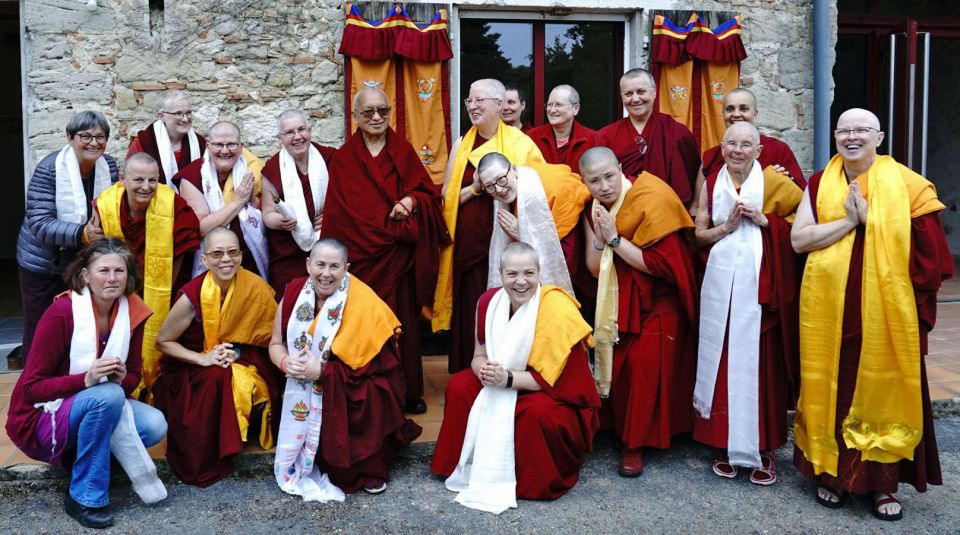
Lama Zopa Rinpoche with students at Dorje Pamo Monastery, En Baut, Fiac, France, January 2018. Photo courtesy of Dorje Pamo Monastery.
The nuns expressed their appreciation at the end of the retreat. They were very grateful for the warm welcome they received. They loved the monastery’s beautiful setting and peaceful environment, and very much appreciated the comfort, kindness, care, and services they were given.
The retreat was a great success; more than 400 retreatants were present during the first ten days, and 236 people finished the complete five-week retreat. The retreat came to a close with a long-life Initiation ceremony open to all, in which 750 people took part.
Lama Zopa Rinpoche widely expressed his satisfaction. He praised Institut Vajra Yogini’s many volunteers (up to a hundred), and was constantly dedicating the merits of practice to their well-being. Rinpoche found the dynamics of the retreat so positive that he said Institut Vajra Yogini should serve as an example for the entire FPMT organization.
Many retreatants took the opportunity to visit Dorje Pamo Monastery after their retreat period was over. They were delighted by the place and showed great interest in the continuation of the project. Rinpoche visited the new monastery during the retreat. He blessed the gompa, gave oral transmission of “The Protection Wheel of Vajra Armor” and “Black Manjushri,” and gave some advice.
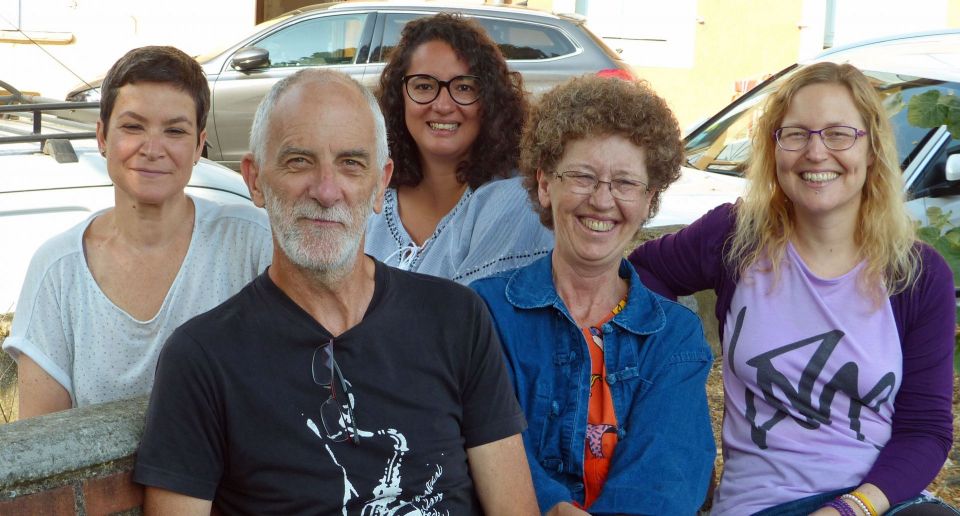
Dorje Pamo Monastery volunteers Jordane De Marliave, Michel Pradines, Ghyslaine Nivet, Gabrielle Leflaive, and Sophie Minon in Lavaur, France, July 2019. Photo by Annick Lainé.
Dorje Pamo Monastery’s monastic community is slowly developing. The goal is to have a core group of a few nuns sharing a monastic life centered on common and individual practices, study, and service. The monastery reached its full accommodation capacity now that the main construction work has been completed and the bedrooms set up.
Various nuns and lay women have stayed in the monastery since September 2018, when we moved into the monastery. Ven. Losang Dekyi moved in with us but then left in mid-December 2018 after completing the Basic Program’s Lorig module at nearby FPMT monastery Nalanda Monastery; she went to do a one-year retreat at O.Sel.Ling Centro de Retiros, an FPMT center in Spain. This autumn a lay woman aspiring to become a nun is expected to come and stay at the monastery until her ordination.
Between January and March 2019, we enjoyed the energy and the know-how of Ven. Tsekyi, who came from Germany to help with renovation work. She sealed and painted the gompa and future library, built shelves for the laundry room, and did various repair and maintenance tasks. She moved like a tornado through house and premises and left cleanliness and order behind.
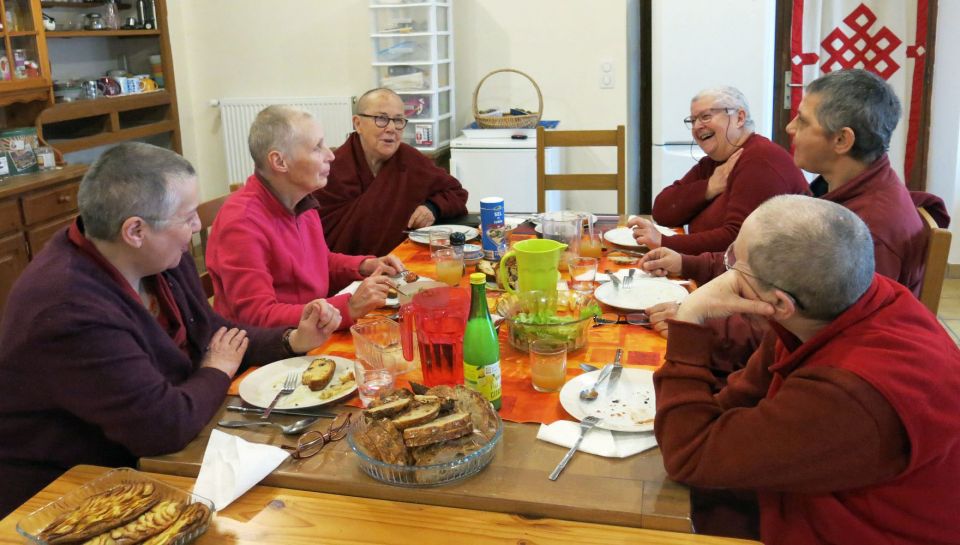
Vens. Michèle Paldreun, Tenzin Ngeunga, Robina Courtin, Thubten Tenzin, Tsékyi, and Tenzin Péma at Dorje Pamo Monastery, En Baut, Fiac, France, January 2019. Photo by Ven. Chantal Tenzin Dekyi.
This past summer the monastery welcomed Ven. Dechen, an Australian nun who along with six other people was recently ordained by Lama Zopa Rinpoche at Nalanda Monastery. Ven. Dechen is doing retreats at Nalanda Monastery and staying at Dorje Pamo Monastery the rest of the time.
Lea Israels, who is a Dutch carpenter, offered to come to volunteer for two weeks in August. We assembled an impressive list of tasks for her. Local nuns and lay volunteers will also be residing for short stays. In this way a monastic community is taking shape. Nuns now have a quiet and peaceful place to live and practice together while striving to preserve and spread the Dharma for the benefit of all beings.
Work on the gompa and library, which began in October 2018, is nearly finished. Teams of volunteers and monks from Nalanda Monastery have completed painting and other jobs. Many thanks to Ven. Yeshe Didier and Lea Israels, who are laying the floor boards in the gompa and library.
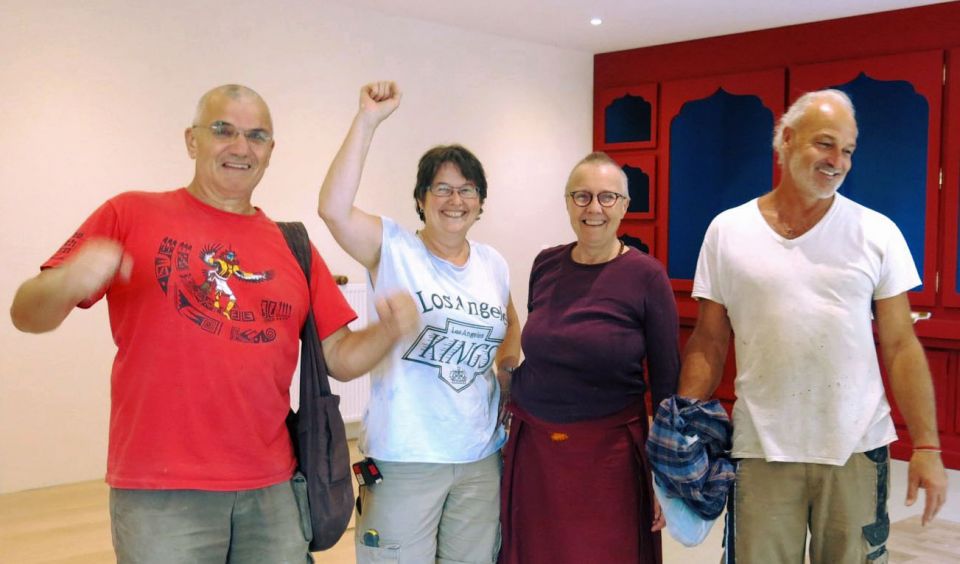
Carpenters Ven. Yeshe Didier, Lea Israels, Ven. Dechen, and Laurenz in front of the new altar at Dorje Pamo Monastery, En Baut, Fiac, France, August 2019. Photo by Ven. Chantal Tenzin Dekyi.
The altar was installed by the cabinetmaker who built and painted it. Lama Zopa Rinpoche would like it to be decorated in classical Tibetan style and suggested a few local artists. We also have to chose the statues for the altar.
We are very grateful for all of the donations we received which enabled us to build the altar. Future projects include furnishings for the gompa, which include altar decoration, statues, thangkas, a throne, carpets, cushions, tables, and audio-visual equipment.
For more information about Monastère Dorje Pamo (Dorje Pamo Monastery), visit their website:
http://monasteredorjepamo.org/en/
FPMT.org and Mandala Publications brings you news of Lama Zopa Rinpoche and of activities, teachings and events from over 160 FPMT centers, projects and services around the globe. If you like what you read, consider becoming a Friend of FPMT, which supports our work.
- Home
- News/Media
- Study & Practice
- About FPMT Education Services
- Latest News
- Programs
- New to Buddhism?
- Buddhist Mind Science: Activating Your Potential
- Heart Advice for Death and Dying
- Discovering Buddhism
- Living in the Path
- Exploring Buddhism
- FPMT Basic Program
- FPMT Masters Program
- FPMT In-Depth Meditation Training
- Maitripa College
- Lotsawa Rinchen Zangpo Translator Program
- Universal Education for Compassion & Wisdom
- Online Learning Center
- Prayers & Practice Materials
- Overview of Prayers & Practices
- Full Catalogue of Prayers & Practice Materials
- Explore Popular Topics
- Benefiting Animals
- Chenrezig Resources
- Death & Dying Resources
- Lama Chopa (Guru Puja)
- Lama Zopa Rinpoche: Compendium of Precious Instructions
- Lama Zopa Rinpoche: Life Practice Advice
- Lama Zopa Rinpoche Practice Series
- Lamrim Resources
- Mantras
- Prayer Book Updates
- Purification Practices
- Sutras
- Thought Transformation (Lojong)
- Audio Materials
- Dharma Dates – Tibetan Calendar
- Translation Services
- Publishing Services
- Teachings and Advice
- Find Teachings and Advice
- Lama Zopa Rinpoche Advice Page
- Lama Zopa Rinpoche: Compendium of Precious Instructions
- Lama Zopa Rinpoche Video Teachings
- ༧སྐྱབས་རྗེ་བཟོད་པ་རིན་པོ་ཆེ་མཆོག་ནས་སྩལ་བའི་བཀའ་སློབ་བརྙན་འཕྲིན།
- Podcasts
- Lama Yeshe Wisdom Archive
- Buddhism FAQ
- Dharma for Young People
- Resources on Holy Objects
- Ways to Offer Support
- Centers
- Affiliates Area
- Teachers
- Projects
- Charitable Projects
- Make a Donation
- Applying for Grants
- News about Projects
- Other Projects within FPMT
- Support International Office
- Projects Photo Galleries
- Give Where Most Needed
- FPMT
- Shop
Subscribe to FPMT News
Translate*
*powered by Google TranslateTranslation of pages on fpmt.org is performed by Google Translate, a third party service which FPMT has no control over. The service provides automated computer translations that are only an approximation of the websites' original content. The translations should not be considered exact and only used as a rough guide.Without understanding how your inner nature evolves, how can you possibly discover eternal happiness? Where is eternal happiness? It’s not in the sky or in the jungle; you won’t find it in the air or under the ground. Everlasting happiness is within you, within your psyche, your consciousness, your mind. That’s why it’s important that you investigate the nature of your own mind.







